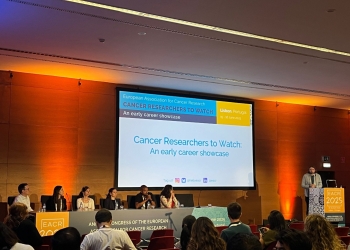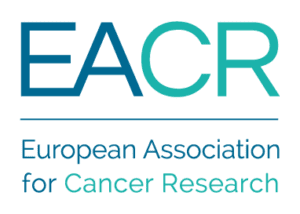The EACR’s ‘Highlights in Cancer Research’ is a regular summary of the most interesting and impactful recent papers in cancer research, curated by the Board of the European Association for Cancer Research (EACR).
The list below appears in no particular order, and the summary information has been provided by the authors unless otherwise indicated.
Use the dropdown menu or ‘Previous’ and ‘Next’ buttons to navigate the list.
7. Cooperative CAR targeting to selectively eliminate AML and minimize escape
Haubner, S. et al. Cancer Cell 41(11), 1871-1891.e6 (2023).
doi: doi.org/10.1016/j.ccell.2023.09.010.
 Summary and graphical abstract by Alexandra Boitor, EACR Scientific Officer
Summary and graphical abstract by Alexandra Boitor, EACR Scientific Officer
Summary of the findings
Currently, the only curative therapy for Acute Myeloid Leukemia (AML) is hematopoietic stem cell transplantation, which has increased treatment-related mortality. Moreover, relapse or refractory disease is common, to a great degree due to disease heterogeneity. Therefore, there’s an acute need for new treatment approaches. CAR therapies have been proposed and tested; however, they’ve been largely ineffective due to increased disease heterogeneity and a high degree of similarity between leukemic cells and normal hematopoietic stem/ progenitor cells (HSPCs).
In this paper, Haubner et al. quantitatively profiled the expression of surface target proteins in bone marrow and peripheral blood samples from healthy individuals and AML patients with diverse genetic subtypes aiming to develop a combinatorial CAR therapy strategy. The authors of this paper identified differential expression of ADGRE2 and CLEC12A between leukemic and healthy hematopoietic cells. Expression of ADGRE2 appears to be relatively homogeneous across different AML subtypes, thus distinguishing as a promising target for therapy. Haubner et al. developed a novel IF-BETTER gated combinatorial CAR approach (ADCLEC.syn1) based on these two proteins: ADGRE2 is used as a CAR target and the treatment sensitivity is increased by co-engagement of a chimeric co-stimulatory receptor (CLEC12A) to expand the range of overall targetable cells. This approach exhibited high in vivo efficacy and limited off-target toxicity at clinically feasible dosing showing an increased potential for complete tumour eradication even at limiting CAR densities. This study also highlights a role for IFN-γ in mediating off-target hematotoxicity.
The CAR therapy approach described in this paper is currently being evaluated in a phase 1 clinical trial in patients with relapse or refractory AML.

7. Cooperative CAR targeting to selectively eliminate AML and minimize escape
![]() Summary and graphical abstract by Alexandra Boitor, EACR Scientific Officer
Summary and graphical abstract by Alexandra Boitor, EACR Scientific Officer









